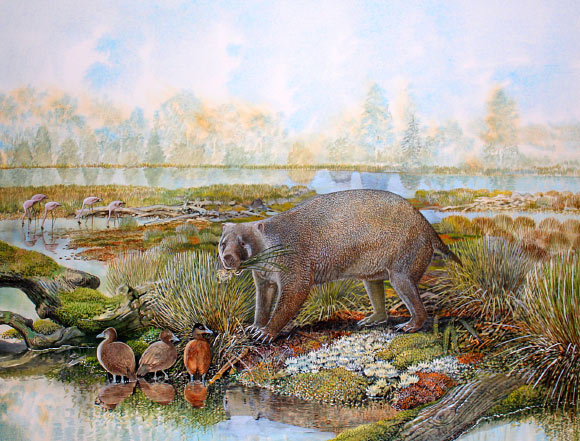Mukupirna fortidentata looked a bit like a modern wombat crossed with a marsupial lion (Thylacoleo carnifex).

An artist’s impression of Mukupirna nambensis living in central Australia that was much greener 25 million years ago. Image credit: Peter Schouten.
Mukupirna fortidentata lived in Australia during the Oligocene epoch, approximately 25 million years ago.
This creature is only the second known member of Mukupirnidae, a family of marsupials erected less than three years ago for Mukupirna nambensis.
Mukupirnids are thought to have diverged from a common ancestor with wombats over 25 million years ago.
“Three species of wombat (Vombatidae) and the koala (Phascolarctidae) are the only living representatives of a once diverse radiation of vombatiform marsupials,” said Arthur Crichton, a Ph.D. candidate at Flinders University, and colleagues.
“This suborder included the largest Australian marsupial herbivores, with six extinct families recognized, namely: Diprotodontidae, Palorchestidae, Ilariidae, Wynyardiidae, Maradidae and Mukupirnidae.”
“Our view of the divergences between these families, and Australian marsupial families more generally, has been concealed by the temporal gap in the known fossil record from the Early Eocene (55 million years ago ) to the Late Oligocene (25 million years ago).”
“By the Late Oligocene, all eight vombatiform families had already evolved uniquely specialized jaws, exacerbating the challenge of resolving their interrelationships.”
Mukupirna fortidentata looked a bit like a modern wombat crossed with a marsupial lion.
The animal had a suite of morphological features that are unusual among ancient vombats, which the authors interpret as adaptations for acquiring and processing hard plant material.
These include: a short, broad snout; large, robust, steeply upturned incisors; and a steep, anteroposteriorly decreasing gradient in cheek tooth size.
“Weighing in at around 50 kg, Mukupirna fortidentata was among the largest marsupials of its time,” the paleontologists said.
“Everything about its skull and jaws shows this animal had a pretty powerful bite.”
“Its front teeth, for example, were large and spike-shaped, being more like those of squirrels than wombats.”
“These would have enabled them to fracture hard foods, like tough fruits, seeds, nuts and tubers.”
“Its molars, by comparison, were actually quite similar to those of some monkeys, such as macaques.”
A total of 35 specimens, including a partial skull and several lower jaws, of Mukupirna fortidentata were found between 2014 and 2020 at the Pwerte Marnte Marnte fossil site, Northern Territory, Australia.
“The dental material from Mukupirna fortidentata assists in the identification of two further allied species: a vombatid from the younger Late Oligocene Tarkarooloo Local Fauna, South Australia; and a vombatoid from the earliest Miocene Geilston Bay Local Fauna, Tasmania,” the researchers said.
“The Lake Tarkarooloo species, in particular, provides support that early vombatids were present by at least 24.1 million years ago in the Late Oligocene.”
“This would imply that representatives from all three referred vombatoid families had originated by the Late Oligocene.”
A paper on the findings was published this month in the Alcheringa: An Australasian Journal of Palaeontology.
_____
Arthur I. Crichton et al. A new species of Mukupirna (Diprotodontia, Mukupirnidae) from the Oligocene of Central Australia sheds light on basal vombatoid interrelationships. Alcheringa: An Australasian Journal of Palaeontology, published online March 19, 2023; doi: 10.1080/03115518.2023.2181397







